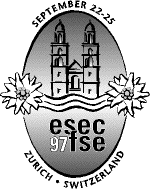
Zurich
The Venue | Zurich | Switzerland
Traveling to Zurich
Social Events
Sightseeing and Excursions
|
|
|
About Zurich
The city of Zurich (follow these links for a city map (587K) or a map of Zurich's central area (510K)) is 409 m (1340 ft) above sea level at the northern end of Lake Zurich. With a population of 360 000, Zurich is the largest city in Switzerland. When including the suburbs, the region of Zurich is inhabited by about 1 million people.
Zurich was founded as a Roman customs post in the year 15 B.C. Since the tenth century, Zurich has possessed the rights of a city. In 1391, Zurich joined the League of Confederates which evolved into Switzerland in the following centuries. Since the 19th century, Zurich has been the financial and economic center of Switzerland.
Zurich's international reputation also rests on its excellent shopping facilities, its beautiful geographic location, its theatres, and museums.
Zurich's Bahnhofstrasse is well known as one of the most attractive shopping streets in the world.
Find more about Zurich here. If you understand German, visit this site, too.
Preview Zurich's sightseeing highlights.
Public Transport
Together with the confirmation of your registration you will receive a ticket for the Zurich public transport system which is valid from Sunday, Sept. 21 through Friday, Sept. 26. This ticket entitles you to free travel on all trams (street cars), buses, trains, and boats within the zones 10 and 21 during these six days. These zones include Zurich city and Zurich airport.
Both the conference venue and the hotels are easily reached by public transport, which runs from 5:15 a.m. to midnight. Trams and buses run about every 7 minutes during the day and about every 15 minutes in the early morning and late evening. Trains typically run at intervals of 30 or 60 minutes.
You find the timetable of the Swiss Federal Railways on the web. When you want to look up connections to or from Zurich main station, enter Zurich HB in the corresponding field of the timetable form.